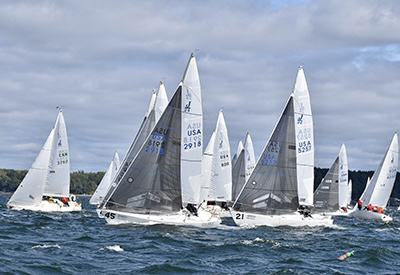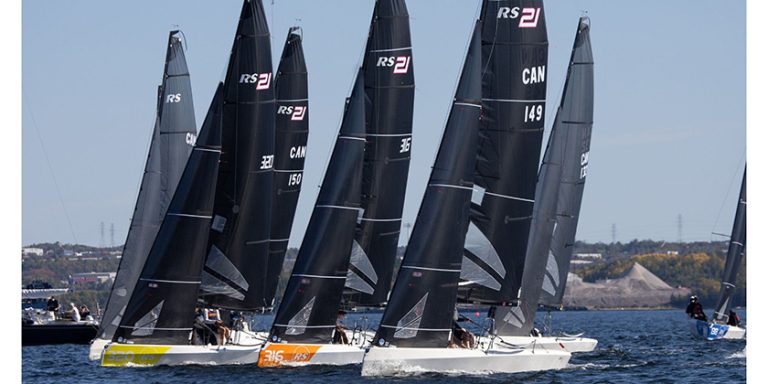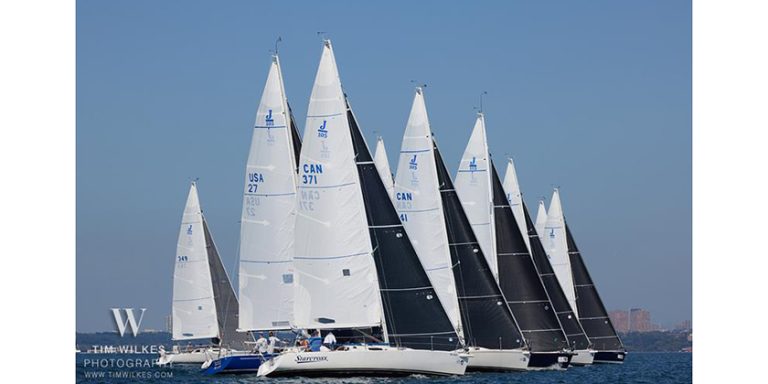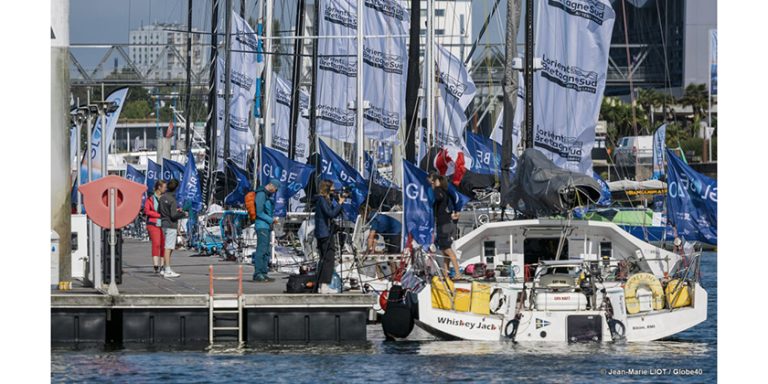The 17 Commandments…

August 2, 2023
by Roger Renaud
Racing a sailboat, especially one-design racing, makes a sailor learn a new set of skills, tactical skills, needed to navigate through that 10 – 40 boat fleet of identical boats to win races.
There are two distinct areas of focus for the tactician: First, it’s defining an overall strategy for the race, and second, the more detailed tactical aspects involved with the interaction between the other competitors on the racecourse. There has been that long-standing debate about whether a racing sailboat should have two separate people assigned to the task of navigating the racecourse: a strategist, and a tactician. The strategist would deal with the geography aspects of the race area, which would include the topics involving currents, shoreline effects, and of course the weather, and weather forecasts. The strategist would define where the boat needs to position itself on the racecourse. The tactician and the team, are then responsible to get the boat to that desired spot, and as fast as possible.
The interactions between boats are decided by the tactician. If during the execution of the race, the tactics and maneuvering have taken the boat, let’s say, toward the wrong side of the playing field. It would be the strategist who would have the responsibility to intervene. Never have I known a boat/competitor to have two individuals with these separate areas of focus. The tactician, as we commonly know the role, must consider both aspects when planning and executing the race.
One design keel experience
Back in the early 1980’s, I belonged to Ashbridge’s Bay Yacht Club in Toronto. The commodore of the time declared ABYC to be a “One-design Club”. Our recruiting, membership policies, and racing programs gave priority to one-design fleets. We raced Tuesday and Thursday nights and on weekends so a fleet would get three – five starts over each week. Fleet sizes ranged from ten to 30 boats. This was a good decision for the club. The one-design fleets grew, and the dry-sail area also expanded. AB’s one-design sailors were always on the podium.
After racing four days per week (5 – 7 races on average), here are some observations. These rules of engagement were arrived at through 35 years of one-design experience, racing in the: Thunderbird, E-22, Laser 28, J24, CC27, CC34, CC99, and Beneteau 36.7 fleets.
In no particular order:
- if after the start you find yourself in a clump of boats with bad air, tack immediately. Do not hesitate. Take transoms if needed. Get clean air, then race your In light winds, clear air is most important.
- always know where you are on the racecourse – everything depends on this
- always know where the weather mark is – the direction to the weather mark – this becomes the basis for subsequent decisions
- if there is a persistent shift towards the right, go right first (real or forecasted)
- if there is a persistent shift toward the left, go left first (real or forecasted)
- in an oscillating breeze, position yourself to be on the inside of a lift
- in an oscillating breeze, you want to always sail on the lifted tack
- in an oscillating breeze, if you find yourself “out of phase”, tack immediately to get back into phase
- in an oscillating breeze, on a lifted tack, foot to the knock
- in an oscillating breeze, on a knock, pinch…. sail as high as you can
- Always stay between the competition and the mark.
- never leave your wing-man (never break cover)
- do not get to the lay-lines to early
- avoid situations with other boats – sail away – sail your own race. Stay focused.
- always know where your competition is on the racecourse
- learn the strengths and weaknesses of your competition
- when a wind sheer presents itself, the direction of the wind shown at the Windex will become the new wind. i.e. Go to the right if it’s coming from the right – go to the left if it’s coming from the left
A tactician’s job is a tough job! There is a lot to think about. There is always a lot to consider when making a decision. Try not to distract your tactician.
 Born in Windsor, Ontario, Roger moved to Toronto for work in the early 70’s where he sailed a Hobie off Cherry Beach. Eventually joining ABYC, he has owned three different Thunderbirds over the years. The Thunderbird, 8-meter, E-22, Laser 28, CC27, CC34, CC99, and the Beneteau First 36.7’s, were the other one-design fleets he raced in, each for a few years dedicated to a program. He was also involved in a significant three-year program on the NM 36, Maggie Kelly.
Born in Windsor, Ontario, Roger moved to Toronto for work in the early 70’s where he sailed a Hobie off Cherry Beach. Eventually joining ABYC, he has owned three different Thunderbirds over the years. The Thunderbird, 8-meter, E-22, Laser 28, CC27, CC34, CC99, and the Beneteau First 36.7’s, were the other one-design fleets he raced in, each for a few years dedicated to a program. He was also involved in a significant three-year program on the NM 36, Maggie Kelly.
Since returning to Essex County, he has been racing locally and in the Detroit (DYRA) PHRF divisions on his restored Pearson Flyer.















